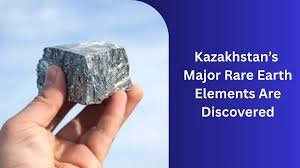Discovery of Rare Earth Elements in Kazakhstan
In a significant development with potential geopolitical and economic implications, Kazakhstan has announced the discovery of major rare earth element (REE) deposits within its territory. These elements are crucial for the global technology sector, especially in the manufacturing of semiconductors, electric vehicles, defense systems, and renewable energy technologies. The country’s government stated that the reserves discovered include critical elements such as neodymium, dysprosium, and terbium, all vital for the future of clean and high-tech industries.
Location and Significance of the Reserves
The newly discovered rare earth deposits are concentrated in regions like Kostanay, East Kazakhstan, and Aktobe. These regions are known for their mineral richness, but this discovery enhances Kazakhstan’s strategic value in the global rare earth supply chain. With over 30% of the global REE demand dominated by China, Kazakhstan’s entry into the market could help balance international supply and reduce overdependence on a single country.
Economic and Geopolitical Implications
This discovery is expected to boost Kazakhstan’s economy by attracting foreign investments, particularly from countries aiming to diversify their rare earth sources. Additionally, the country could become a major exporter of rare earth materials, giving it greater leverage in international trade and diplomacy. For India and other developing countries, this could mean more competitive pricing and diversified sourcing options for crucial materials.
Environmental and Developmental Challenges
While the discovery is economically promising, Kazakhstan faces the challenge of environmentally sustainable mining practices. Rare earth mining often causes ecological harm if not managed correctly. The country has assured the international community that it will adopt eco-friendly and scientifically robust methods to extract and process these resources responsibly.

📌 Why This News is Important
Relevance for Competitive Exams
For students preparing for exams like UPSC, PSC, SSC, and Defence, this news links directly to topics under geopolitics, science & technology, environment, and international relations. Questions about global REE reserves, Kazakhstan’s role, and rare earth significance in national security and green technology are highly probable.
Strategic Impact on Global Economy
Kazakhstan’s discovery is not just a local event—it has the potential to reshape global supply chains, which are currently monopolized by China. As nations, including India, focus on self-reliance in strategic minerals, this discovery offers potential partnerships and market alternatives. Thus, this news has both economic and strategic implications that aspirants should understand.
🕰️ Historical Context: Rare Earth Elements and Global Power Play
Rare Earth Elements (REEs) have long been central to modern technological advancement. China has been the world’s leading supplier of REEs, accounting for nearly 85% of global production for decades. The U.S. and other Western countries have previously accused China of using REEs as a geopolitical tool during trade disputes. Countries like Australia and the U.S. have recently ramped up efforts to explore alternate sources of REEs. Kazakhstan’s entry into this space marks a strategic shift in global resource distribution, especially within Central Asia.
📋 Key Takeaways from “Kazakhstan’s Major Rare Earth Elements Discovery”
| S.No | Key Takeaway |
|---|---|
| 1. | Kazakhstan has discovered significant reserves of rare earth elements (REEs). |
| 2. | Key elements found include neodymium, dysprosium, and terbium. |
| 3. | Deposits are located in Kostanay, East Kazakhstan, and Aktobe regions. |
| 4. | This could reduce global dependence on China for REE supply. |
| 5. | Kazakhstan aims for environmentally sustainable mining practices. |
FAQs: Frequently Asked Questions
1. What are Rare Earth Elements (REEs)?
Rare Earth Elements (REEs) are a group of 17 chemically similar elements essential for the production of high-tech devices, green energy equipment, and defense technologies.
2. Why is Kazakhstan’s discovery of REEs important?
Kazakhstan’s discovery adds a new player to the global rare earth supply chain, potentially reducing dependence on China and stabilizing prices globally.
3. Which rare earth elements were discovered in Kazakhstan?
Key elements include neodymium, dysprosium, and terbium, all of which are vital for making magnets used in electric vehicles and wind turbines.
4. Where in Kazakhstan were the rare earth elements found?
The discoveries were made in Kostanay, East Kazakhstan, and Aktobe regions, known for their rich mineral resources.
5. How does this discovery affect India?
India can benefit from a diversified supply of critical minerals and potential bilateral cooperation with Kazakhstan to support its clean energy and technology sectors.

